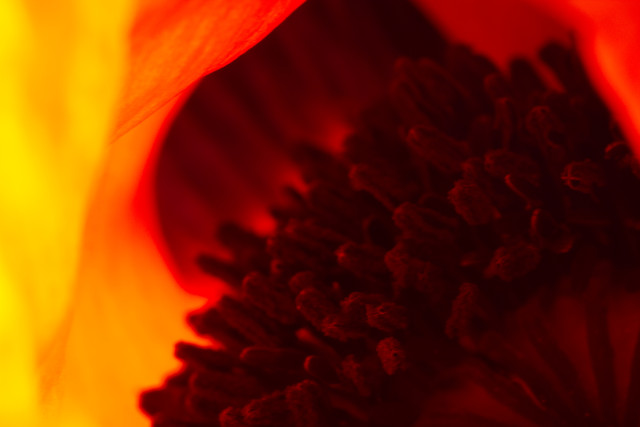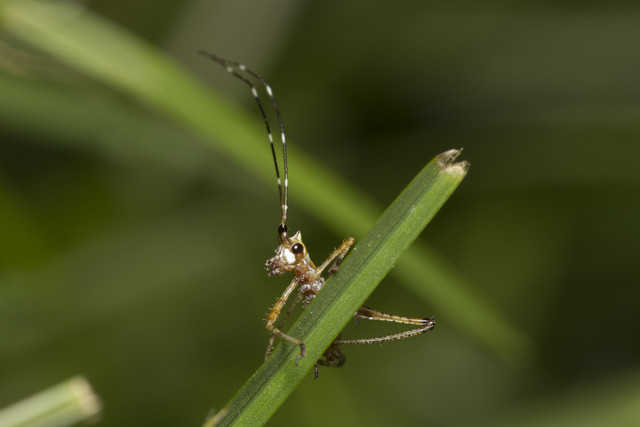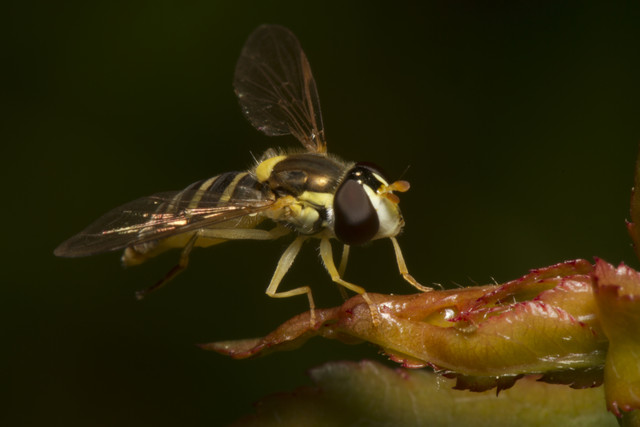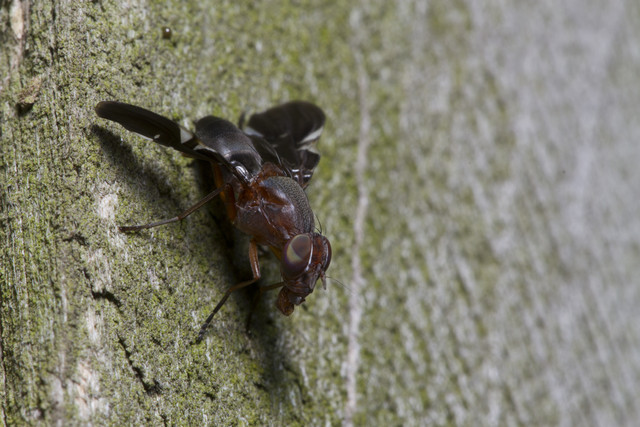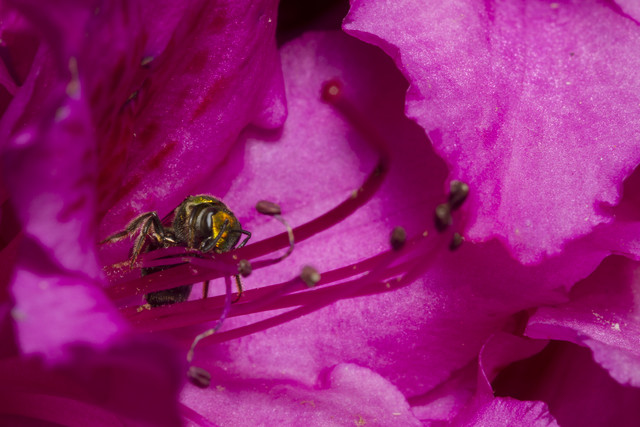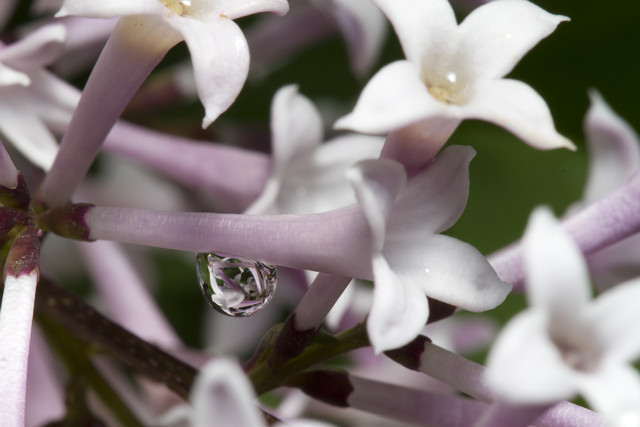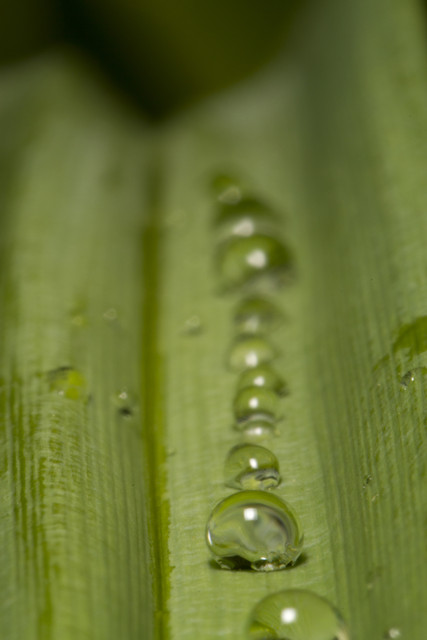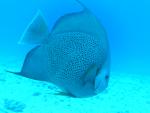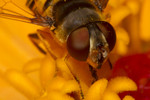macro
Flashed Poppy
ktuli — Sun, 06/05/2011 - 21:11
 I stopped by my parents' house this afternoon, and had a request for fewer bug shots. I have a stack of bug shots to share, so this will be a quick break (sorry, mom).
I stopped by my parents' house this afternoon, and had a request for fewer bug shots. I have a stack of bug shots to share, so this will be a quick break (sorry, mom).
These shots are of a poppy blossom. Though the perspective and the lighting and the end result are kind of interesting.
First, the view is a macro view down inside the blossom of the pollen stamens. While that isn't necessarily unique, the lighting is kind of interesting. I used my flash to shine up through the petals of the flower to illuminate the shot.
The result is that the light is diffused through the petals and picked up the reddish-orange color. So while the pollen stamens were black, they appear red in the shot.
Technical Data: Canon EOS 7D, Canon EF 100mm f/2.8L Macro IS USM, 1/250 sec at f/16. Canon Speedlight 580EX II flash in auto mode and wireless control. Image Stabilization on. ISO 160. RAW processing in Adobe Camera Raw.
The shots were challenging to get because I hand-held the whole thing. With one hand, I was holding the camera with the 100mm macro (not a light setup) trying to keep it at the minimum focusing distance, and with the other hand I was reaching below the flower to illuminate the shot. I probably should have been using at least one tripod (possibly two) to do all of this, but i simply couldn't be bothered... as usual.
I really like how the shots become an abstract view, and almost have the feel of an electron microscope view.
Technical Data: Canon EOS 7D, Canon EF 100mm f/2.8L Macro IS USM, 1/250 sec at f/16. Canon Speedlight 580EX II flash in auto mode and wireless control. Image Stabilization on. ISO 160. RAW processing in Adobe Camera Raw.
Interesting, no? Drop me a comment and let me know what you think. Sorry - tomorrow, we go back to the bugs.
- Bill
Posing Katydid Nymph
ktuli — Fri, 06/03/2011 - 16:19
Ok - we'll get back to the crab spider soon, I promise. But last night I went out to see about photographing the crab spider again, and happened to find this little guy...
Technical Data: Canon EOS 7D, Canon EF 100mm f/2.8L Macro IS USM, 1/250 sec at f/11. Canon Speedlight 580EX II flash in auto mode and wireless control. Image Stabilization on. ISO 160. RAW processing in Adobe Camera Raw.
Why This Photo: I've never seen a katydid nymph like this before, and I decided to spend some time with it to see what kind of good shots I could come up with. When I saw it climbing on this blade of grass, I figured a good pose would come of it, and when I saw it get into the classic tree-frog pose, I fired off a shot. I think it's a keeper...
What Works: First, the pose is the biggest thing here... I literally waited and worked with this katydid nymph for 35 minutes to get this shot. I also moved from position to position - starting on a peony flower, down to some hosta leaves, and finally down to the grass. To get the shot, I was laying on the ground so I could get an eye-level view of the katydid nymph. The focus is sharp, and the depth of field has almost the whole katydid nymph in clarity (except for the ends of the antennae).
What Doesn't Work: The bright blade of grass running the opposite angle in the background is somewhat distracting, and the white patch on the katydid nymph's face below its eye is a little over-powering (though that is how it was, so there isn't much I could do about it).
I think the main point from this is that I was rewarded by following some of those "rules" to photography. I worked with the subject to make sure I took multiple shots with multiple angles to provide myself with a higher possibility of scoring a nice photo. I also got down to eye level - even if it meant laying in the grass - so that the shot was engaging rather than flat. Finally I observed my subject and waited for that decisive moment to present itself.
I have more shots of this little guy, and I'll be sharing them and the crab spider shots next week. Thanks for stopping by.
- Bill
Return of the Crab Spider
ktuli — Thu, 06/02/2011 - 19:54
Yeah - I know... that sounds like a B horror film title, but if you remember - I had a run-in with a crab spider last year too (posts: 1, 2, and 3). Unfortunately, I have some more photos to process tonight, so just sharing one photo, and I'll discuss details on future posts.
Technical Data: Canon EOS 7D, Canon EF 100mm f/2.8L Macro IS USM with Kenko Teleplus PRO 300 "DG" AF 2x Teleconverter, 1/250 sec at f/16. Canon Speedlight 580EX II flash in auto mode and wireless control. Image Stabilization on. ISO 160. RAW processing in Adobe Camera Raw.
I have some really fun stuff to share... soon.
- Bill
Getting Closer: Bug Macros
ktuli — Tue, 05/31/2011 - 21:21
I know they're not popular with most folks, but I really like macro photos - particularly of insects. I've really been trying to improve my techniques to get better macro shots, and recently, I managed to achieve some better shots that included macro focus that actually shows the multi-faceted eyes of the bugs I was shooting.
Technical Data: Canon EOS 7D, Canon EF 100mm f/2.8L Macro IS USM with Kenko Teleplus PRO 300 "DG" AF 2x Teleconverter, 1/250 sec at f/16. Canon Speedlight 580EX II flash in auto mode and wireless control. Image Stabilization on. ISO 160. RAW processing in Adobe Camera Raw. Full size.
Technical Data: Canon EOS 7D, Canon EF 100mm f/2.8L Macro IS USM, 1/250 sec at f/16. Canon Speedlight 580EX II flash in auto mode and wireless control. Image Stabilization on. ISO 160. RAW processing in Adobe Camera Raw. Full size.
It isn't easy to see in the resized versions, but in the full size versions, you can most definitely see the facets of the eyes on these bugs. Maybe some more work and I can nail these kinds of shots all the time.
Though I'm sure plenty of folks won't be pleased to see more bugs on the site...
- Bill
Warning: Adult Spider Content
ktuli — Thu, 05/26/2011 - 20:59
OK - I'll be honest, I originally had a nice calm (I'd go so far as to call it "dreamy" even) flower photo all set to share for today, but then I realized that this is my 200th post, and since I did a spider post for my 100th post, I figured I'd stick with it and share this set for my 200th. My apologies in advance to those of you who don't like spiders, I promise to share that flower photo tomorrow to make up for it.
Anyway.... our front yard is surrounded by a lot of ground vines and hostas and other low plants like that, and this time of year, they get carpeted with spiderwebs. I'm not entirely certain of the exact species (it might be Frontinella communis, but I really need to buy a good spider identification guide), but I think it is some species of sheet web. Regardless, one of the interesting things about them is that the male and female live together in the web for several days to a couple weeks.
I've tried many times in the past to photograph them, and it rarely turns out well. They are usually in hard to reach locations, making tripod use difficult, and I often have to avoid crushing Anya's flowers and plants. Their webs are extremely chaotic - not like a nice clean orb weaver web which is flat and exists on a single plane, these webs are random and usually several inches thick and that causes them to catch the light from multiple angles. And they're rather small too - probably in the range of 1/4".
But this year I was determined to try again... Ok I think I blabbered enough to get the photos off the top of the screen for those of you who dislike spiders.
Warning: The following contains adult spider content. Viewer discretion is advised.
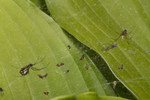 |
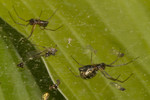 |
 |
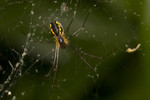 |
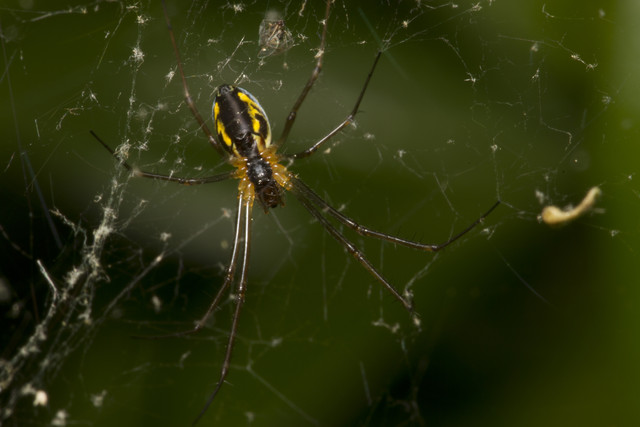 | |||
 |
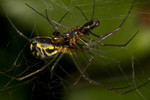 |
 |
 |
Technical Data: Canon EOS 7D, Canon EF 100mm f/2.8L Macro IS USM, 1/160, 1/200, or 1/250 sec at f/16. Canon Speedlight 580EX II flash in auto mode and wireless control. Image Stabilization on. ISO 160. RAW processing in Adobe Camera Raw. Last three photos with Kenko Teleplus PRO 300 "DG" AF 2x Teleconverter.
So, the top row of photos all basically just show the spiders. The female is the slightly larger one with the yellow stripes along her abdomen. In the first couple shots, you can see just how effective they've been at trapping various bugs, and can see how they are coexisting with each other in the same web peacefully.
The bottom row of photos all depict their mating behavior. The male would drum on the females abdomen with his pedipalps (the short "arms" by his head - in this species they look like they have large brown boxing gloves on them). After that he would either inflate an organ there or secrete a yellowish liquid (I'm honestly not sure which it was), and then pass a sperm packet to the female (the organ would deflate or the yellowish liquid would be absorbed into the female). This went on literally for hours. I stopped back repeatedly hoping to get a photo of the final act... which is the female eating the male after they have finished mating. Unfortunately, I never managed to get that shot.
But I thought capturing the mating behavior of such a tiny little spider was kind of interesting. Since then, I've noticed at least three other pairs of spiders mating as well, and every time I do, the next morning that web is inhabited by only the female. The poor guys have it rough! Then again, the females will hold on to those sperm packets for some amount of time until they're ready to lay eggs, and then fertilize probably several hundred eggs at once. Perhaps having several hundred babies to contend with is why the males willingly let themselves be eaten after mating...
Sorry if the spider photos gave you the heebie-jeebies, but thanks for stopping by for my 200th post. Leave me a comment and let me know what you think of these shots. And I promise I'll share a nice calm flower photo with no adult content tomorrow...
- Bill
Bee on Azalea Flower
ktuli — Tue, 05/24/2011 - 20:29
Technical Data: Canon EOS 7D, Canon EF 100mm f/2.8L Macro IS USM, 1/250 sec at f/16. Canon Speedlight 580EX II flash in auto mode and wireless control. Image Stabilization on. ISO 160. RAW processing in Adobe Camera Raw.
Technical Data: Canon EOS 7D, Canon EF 100mm f/2.8L Macro IS USM, 1/250 sec at f/16. Canon Speedlight 580EX II flash in auto mode and wireless control. Image Stabilization on. ISO 160. RAW processing in Adobe Camera Raw.
Droplet of French Lilacs
ktuli — Tue, 05/24/2011 - 20:12
The same day I found the day lily leaf with water droplets, I found this droplet hanging from one of the french lilacs.
Technical Data: Canon EOS 7D, Canon EF 100mm f/2.8L Macro IS USM, 1/200 sec at f/16. Canon Speedlight 580EX II flash in auto mode and wireless control. Image Stabilization on. ISO 160. RAW processing in Adobe Camera Raw.
I really like how the droplet of water seems to have an alternate world of french lilacs trapped inside. The scene is jam packed with those small lilacs and it still feels like if that drop were to pop that a million more would spill out.
- Bill
Poll: More Water Droplets
ktuli — Fri, 05/20/2011 - 20:43
It has been a while since I've done a poll, and I took several different shots of this day lily leaf with water droplets on it that I feel this is a good way to share them all. So here goes...
 |
Version 1 1/200 sec at f/16 |
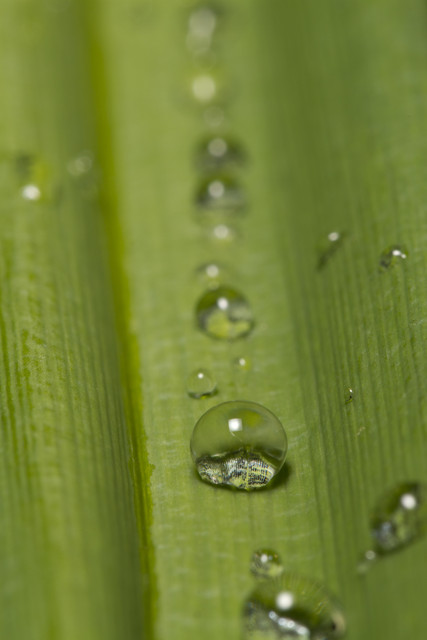 |
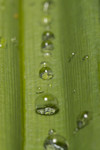 |
Version 2 1/160 sec at f/22 slight crop |
|
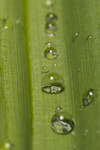 |
Version 3 1/160 sec at f/22 |
|
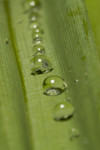 |
Version 4 1/200 sec at f/32 |
|
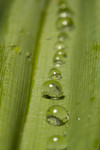 |
Version 5 1/200 sec at f/32 |
Technical Data: Canon EOS 7D, Canon EF 100mm f/2.8L Macro IS USM, shutter speed and aperture as listed. Image Stabilization on. ISO 160. RAW processing in Adobe Camera Raw (and additional cropping as listed).
I know, they all look pretty similar, but after a bit, you really can see just how different each one is. And while the differences may look random, some of them are quite intentional.
For example, you will notice that I specifically switched apertures (smaller opening, larger f/#, more depth of field) to control the depth of field as I went along, which allowed me to get more of the droplets in clarity. (Ignore that for a couple shots the shutter speed switched to 1/160 - I don't know how that happened, and apparently I fixed it after a couple shots). But then I also intentionally played around with the angles, trying to see whether a diagonal view would look better than straight centered.
I will admit that I should have been doing this whole exercise with a tripod (and preferably with a Wimberly Plamp), but I still haven't upgraded my tripod, and as such still don't use the tripod as often as I would like. However, had I done so, we'd probably have three times as many shots to compare here, so maybe it is good that I didn't...
I honestly can't choose which version I like the best. Probably because I like elements of each - some I should have combined for a single better image, and some I simply couldn't combine (ie: liking both the diagonal and the straight centered).
Cast your vote and let me know which one(s) you like best (yes, I opened this one up to multiple selections!) and don't forget to leave a comment letting me know why you picked the one(s) you did.
Thanks!
- Bill
Water Droplets
ktuli — Thu, 05/19/2011 - 19:23
Just going to post a shot I took yesterday. The rain had just eased up for a bit, and I headed out hoping to find some butterflies or bees taking advantage of the the break in the rain, but instead found plenty of shots with water droplets on the various plants. This one was on the leaf of a day lily and the line of drops just screamed to be photographed with the macro lens I had on...
Technical Data: Canon EOS 7D, Canon EF 100mm f/2.8L Macro IS USM, 1/200 sec at f/32. Image Stabilization on. ISO 160. RAW processing in Adobe Camera Raw.
- Bill
Wakatobi: Closed Anemone
ktuli — Tue, 05/17/2011 - 21:01
Most people know what an anemone fish does when it is scared... it goes and hides in the protective tentacles of its host anemone.
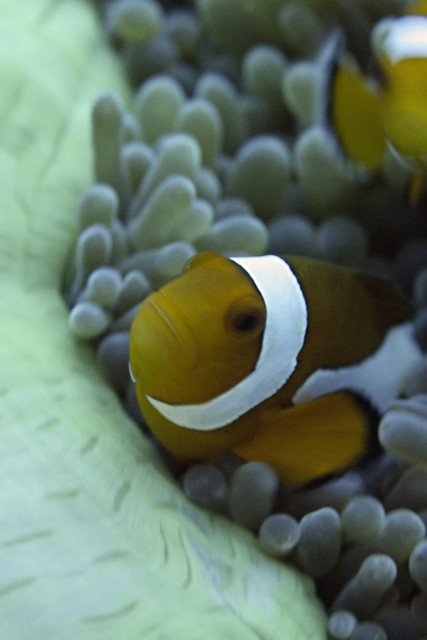
But what about when the anemone gets scared?
It just closes up shop, and that usually means the anemone fish need to push and shove to get some protection.
Technical Data: Canon EOS 7D, Canon EF 100mm f/2.8L Macro IS USM, 1/25th sec at f/8. Image Stabilization on. ISO 3200 (Auto). Ikelite Housing and Port with Ikelite 161 Strobe in TTL Mode. Removed Color Cast, Auto Smart Fix in Photoshop Elements 8.0 (mouseover for original).
As you can see when you mouseover the image, the original shot had a pretty bad blue color cast - likely because the flash did not fire (I often would rapid fire shots, and by the end of the series the flash would be recycling). Luckily, Photoshop does a decent job of cleaning up that color cast.
I don't know why I keep skipping my usual critiques, but I guess I just feel like sharing photos recently - perhaps I'll get back to the regular routine soon.
This one obviously isn't the best focus I've ever achieved, but I still think the shot works well. I also looked at trying to find a different crop for it (mainly to eliminate the partial fish in the top right corner, but couldn't find one I liked. Despite its flaws, I still really like the shot.
If you haven't seen them before, you might want to check these older posts with other anemone fish: False Clownfish and the early Sneak Peak (part 2).
- Bill

